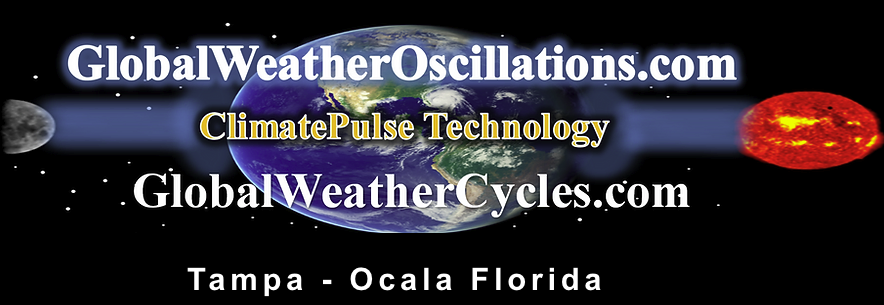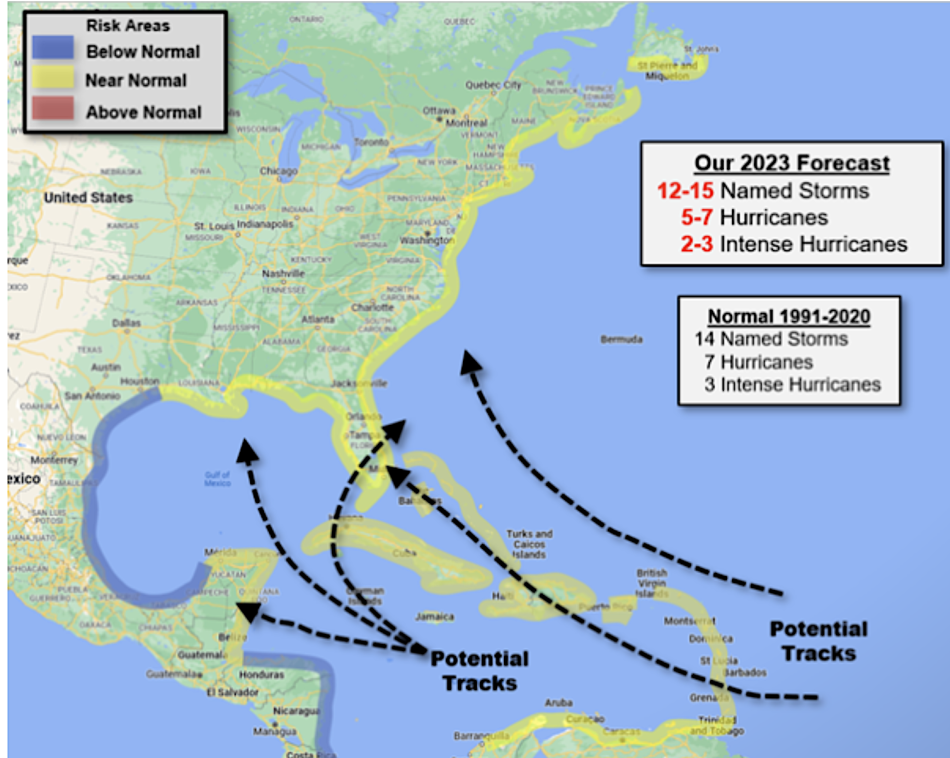2023 Hurricane Predictions – Global Weather Oscillations
The 2023 Atlantic Hurricane Season will have fewer named storms than last year – but will still have United States hurricane landfalls
By PROFESSOR DAVID DILLEY From Global Weather Oscillations
“GWO’s ClimatePulse Hurricane Model predicts landfall locations months in advance – and predicted the locations of all 19 hurricanes that have made landfalls in the United States since 2016”

TAMPA AND OCALA, FLA. (PRWEB) FEBRUARY 10, 2023
Global Weather Oscillations (GWO) predicted the locations of the past 19 hurricanes that have made landfalls in the United States. Last year (2022) was no exception as GWO predicted the locations of both Florida hurricane landfalls months in advance – and predicted that at least one of them would be a very destructive category 4 hurricane. What should we expect in 2023? GWO issues hurricane landfall predictions for 13 United States and Lesser Antilles zones. The predictions are based on GWO’s proprietary ClimatePulse Hurricane Model that is utilized for not only hurricane landfalls, but also El Niño predictions, winter outlooks and climate change. The detailed predictions area available via GlobalWeatherOscillations.com. or GlobalWeatherCycles.com.Hurricane Tracking and Landfalls.
As we have all seen over the past few years, the various computer models used by all forecasting entities typically change landfall locations several times during the 10-day period leading up to the hurricane landfall – with some predicted landfall locations being hundreds of miles from the actual landfall. The computer models typically do not come into full agreement until about 2 days prior a landfall. When this occurs, there is not much time for preparation. This occurred with the Major Hurricanes Irma and Harvey in 2017, and Ian in 2022.GWO’s Tracking and Outlook Webinars.
GWO’s ClimatePulse Hurricane Model predicts landfall locations months in advance – and predicted the locations of all 19 hurricanes that have made landfalls in the United States since 2016. This includes the major hurricanes Harvey, Irma, and Ian. Because GWO knew months in advance where the hurricanes would landfall – the tracking webinars provided much more preparation time for our clients. GWO often begins tracking a hurricane and landfall location 8 to 14 days prior to landfall. Free Outlook Webinars for the upcoming season will begin February 14th and run into May. Weekly interactive tracking and outlook webinars will begin for our clients in May.
GWO’s interactive outlook and tracking webinars go out 2-weeks into the future and are fully interactive – this means that attendees can ask questions and gain more accurate tracking and landfall. Looking at the 2023 Season.
The past 4 hurricane seasons (2018 to 2022) had favorable atmospheric conditions and warm ocean water to help produce above normal and very destructive hurricane seasons The landfalls during the 4 hurricane seasons were enhanced by what Professor Dilley of GWO calls – “ClimatePulse Enhanced Landfall Cycles”. The enhanced landfall cycles occur about every 70-years and produce above normal landfalls and more numerous major hurricane landfalls. This cycle began in 2016 and has produced 20 United States hurricane landfalls during the past 6-years – seven of which were major hurricanes. The prior 7-year period from 2009 into 2015, only had 3 landfalls and no major hurricane landfalls.Prediction for 2023:
Professor David Dilley senior meteorologist for Global Weather Oscillations says – the 2023 season will still be influenced by the ClimatePulse Enhanced Landfall Cycle – but the number of named storms will be diminished somewhat due to an expected El Niño that will develop during the summer. El Niño events typically subdue the number of named storms in the Atlantic Basin – but due to the continuance of the ClimatePulse Enhanced Landfall Cycle – landfalls will still occur during the 2023 season. There will be 11 named storms – 5 hurricanes – 2 major hurricanes – 2 to 3 United States landfalls. There will also be 1 or 2 hurricane and/or tropical storm landfalls in the Caribbean and/or Bahama’s. This is overall much lower numbers than what has occurred during the past 3-years. Last year (2022) had 14 named storms, 8 hurricanes with 2 of the hurricanes land falling in Florida. In 2021 there were 21 named storms and 8 hurricanes. The hyper-active 2020 season had 30 named storms and 14 hurricanes.Professor Dilley stresses – “You should not simply focus on the predicted number of Atlantic Basin named storms. What is much more important is knowing how many United States landfalls there will be – and where they will occur”. The ability to predict landfall locations in advance is the reason Global Weather Oscillations is the foremost organization when it comes to hurricane predictions. – Global Weather Oscillations is a working partner with the International Hurricane Protection Association (INHPA).
END
See also:
February 2023 Update “Atlantic Hurricane Season Forecast 2023” From StormGEO






